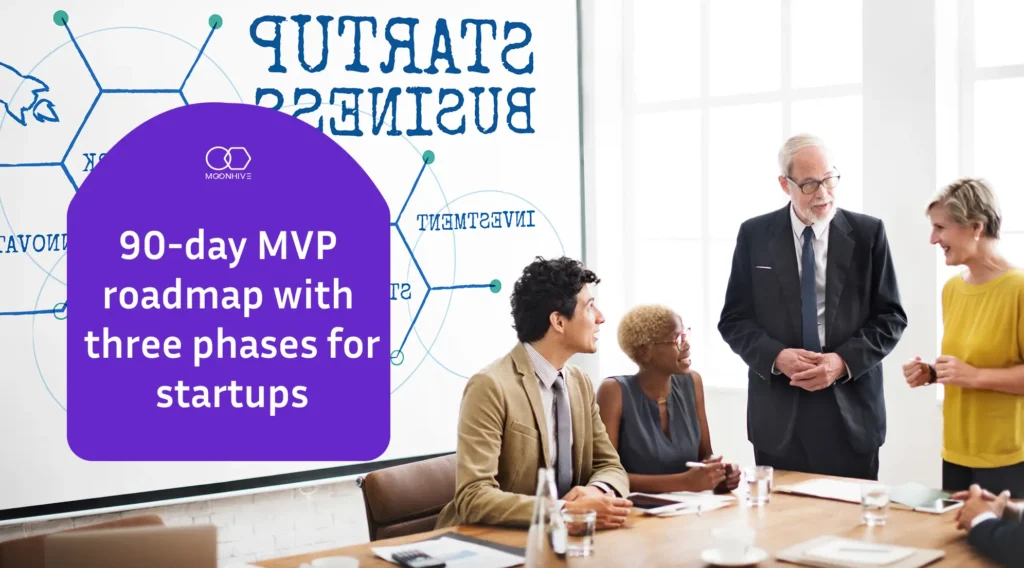For founders in the Middle East, the MVP in 90 Days is more than just a prototype it’s the bridge between vision and validation. Whether you’re pitching to an investor in Dubai, piloting a fintech product in Riyadh, or testing an e-commerce idea in Cairo, building your MVP in 90 Days with speed and clarity is everything.
But here’s the truth: building fast without focus leads to wasted money, endless pivots, and a frustrated team. At Moonhive, we’ve seen this first-hand in different industries. Our blog Why Early-Stage Startups Fail at AI/ML Implementation shows that misalignment between business goals and technical execution is one of the biggest killers.
That’s why we recommend a structured 90-day roadmap not a rush job, but a clear process that balances speed with validation.
Phase One: Clarity & Validation for Your MVP in 90 Days (Day 1-30)
The first month is about asking tough questions and saying no to distractions. This stage prevents you from building features that no one wants.
What you should focus on:
- Define the problem statement clearly. If you can’t describe your user’s pain in one sentence, you’re not ready to build.
- Identify your early adopters. Who will actually test this product? Target people who have urgency, not just interest.
- Prioritize features with ruthless focus. Start with one or two core functions that solve the main pain point.
- Set success metrics now. For example: “50 pilot users in 2 weeks” or “First paying customer before Day 90.”
In our post UK Startup Metrics That Convince Seed Investors, we show how investors look for traction data early even if small. Defining those numbers in Phase One means you’ll know exactly what to measure later. The MVP journey doesn’t begin with code. It begins with alignment between founders, advisors, and the market.
Phase Two: Development & Iteration in the MVP in 90 Days Journey (Day 31-60)
This is where your vision starts to take shape. But remember the goal is not a “mini-enterprise app,” it’s a lean but functional version of your product.
What you should focus on:
- Prototype fast. Use no-code/low-code tools or wireframes to visualize your idea before heavy coding.
- Build a scalable base. Even a simple MVP should be designed with growth in mind. Our article Cloud-based Logistics MVPs shows how early infrastructure choices save massive rebuild costs later.
- Work in short sprints. Two-week sprints with demos keep you from drifting away from the original vision.
- Validate each feature. Release features incrementally to a small test group.
In Building a Cross-Border Logistics Platform, we highlight how ignoring operational complexities early caused delays. Even in MVPs, you need to design for your specific context whether it’s compliance in Saudi Arabia or payments in Egypt. Development in Phase Two should feel like a series of mini-launches, not one big reveal.
Phase Three: Testing, Feedback & Launch of the MVP in 90 Days (Day 61-90)
The final month is all about validation in the real world. At this stage, you shift from “builders” to “learners.”
What you should focus on:
- Pilot testing with real users. Pick 10-50 people from your target segment and give them access.
- Collect data across channels. Track not just usage, but also drop-offs, customer questions, and willingness to pay.
- Run conversion funnels early. Our post Startup Funnels: From MVP to First Conversion shows why funnel discipline matters even at MVP stage it helps you see where users leak out.
- Iterate weekly. Feedback cycles should be fast, with changes pushed every few days.
- Prepare for investor conversations. This is where metrics from Phase One come alive: adoption, retention, revenue experiments.
In Why Early-Stage Startups Fail at AI/ML Implementation, one of the biggest issues was founders waiting too long to test. Don’t make that mistake get feedback by Day 70, not Day 90. A launch isn’t an end it’s the beginning of data-driven iteration.
Conclusion
An MVP is more than a product it’s your proof of momentum. The structured 90-day roadmap ensures you build quickly without skipping the steps that actually win investors and customers. Moonhive has guided startups in fintech, logistics, and AI across the MENA region through this exact process.
